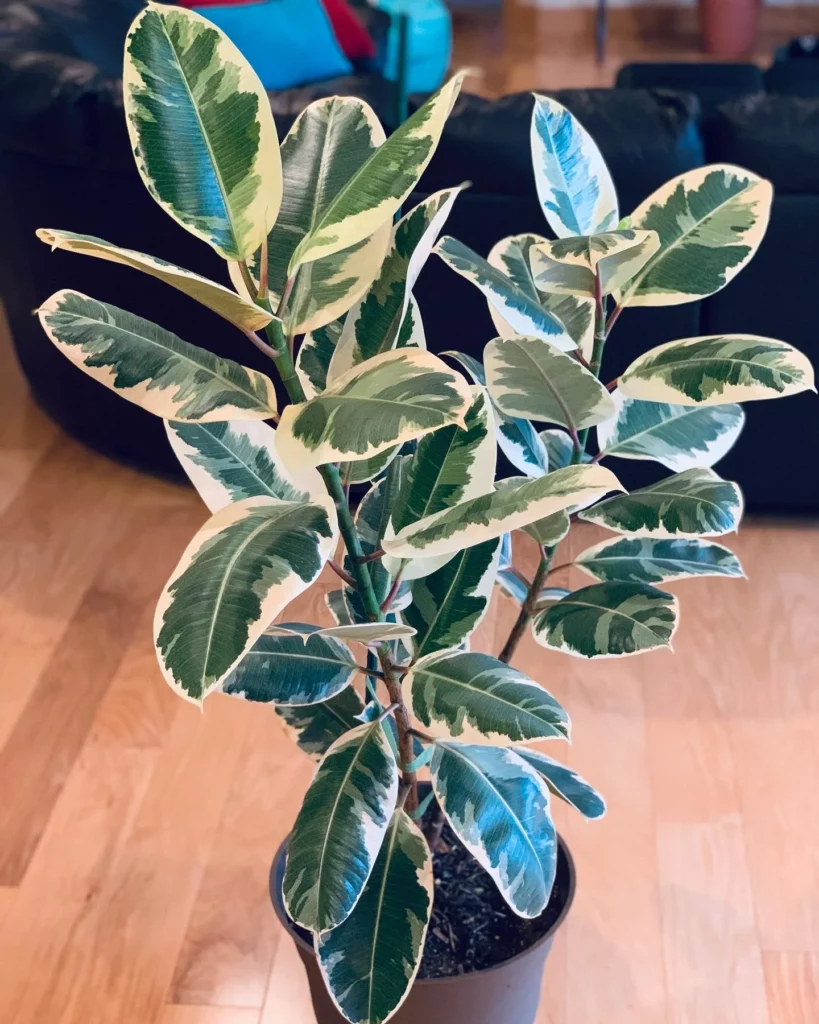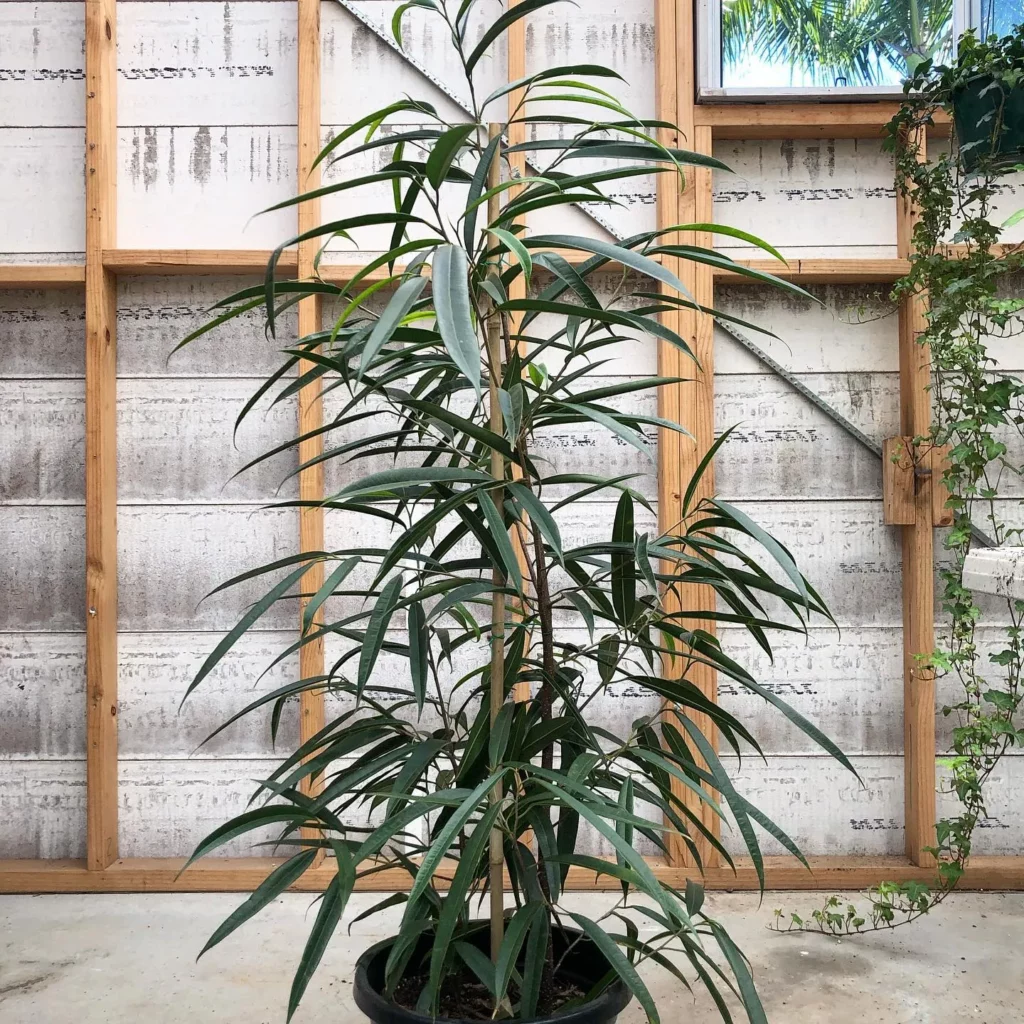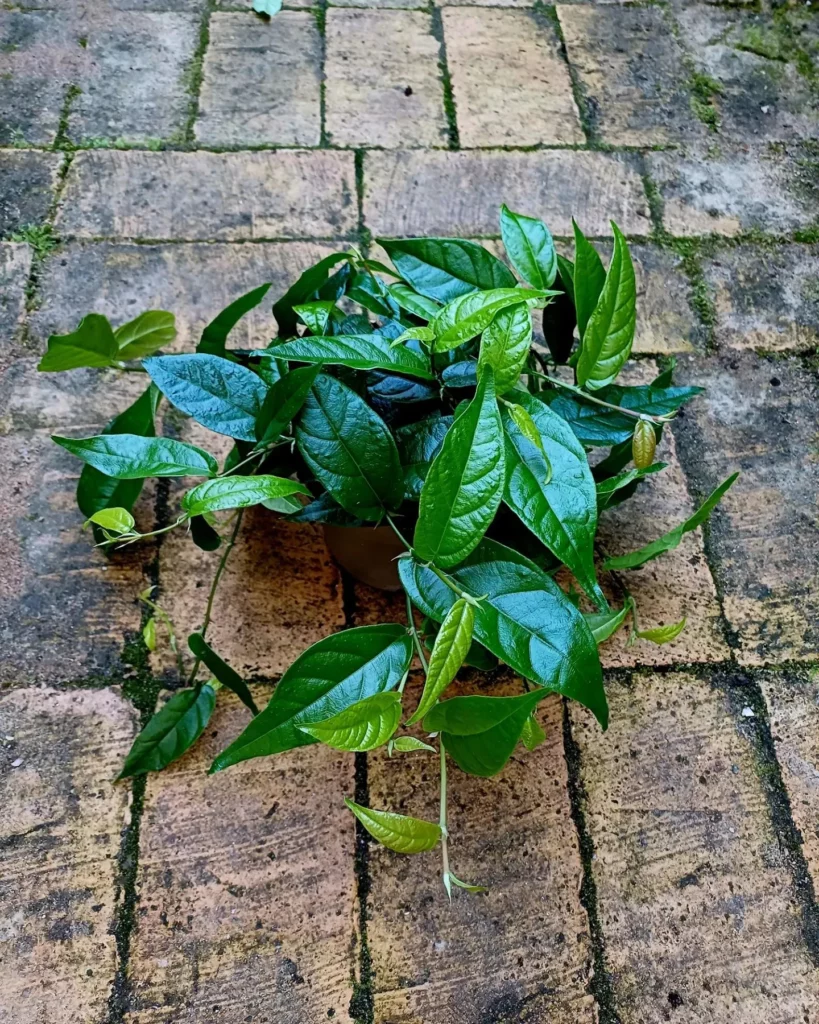The Ficus benjamina Variegata, also known as Variegated Ficus benjamina, is a stunning plant characterized by its lush green leaves adorned with creamy white variegation.
This attractive foliage makes it a popular choice for both indoor and outdoor gardens. Not only does it add a touch of elegance to any space, but it also provides numerous health benefits such as purifying the air and reducing stress levels.
Key Takeaways:
- The Ficus benjamina Variegata thrives in bright locations with indirect light and high humidity.
- Water the plant when the top 2-3 inches of soil is dry, and use filtered or distilled water to prevent hard water marks.
- Be aware of pests such as mealy bugs, spider mites, thrips, and scale, and take appropriate measures for prevention and control.
- Avoid prolonged direct sunlight, overwatering, and contact with the sap, which can cause skin and eye irritation.
- Indoor and outdoor growing is possible in warmer zones 10-11, but ensure the plant is protected from extreme temperatures.
Ficus benjamina Variegata: An Overview
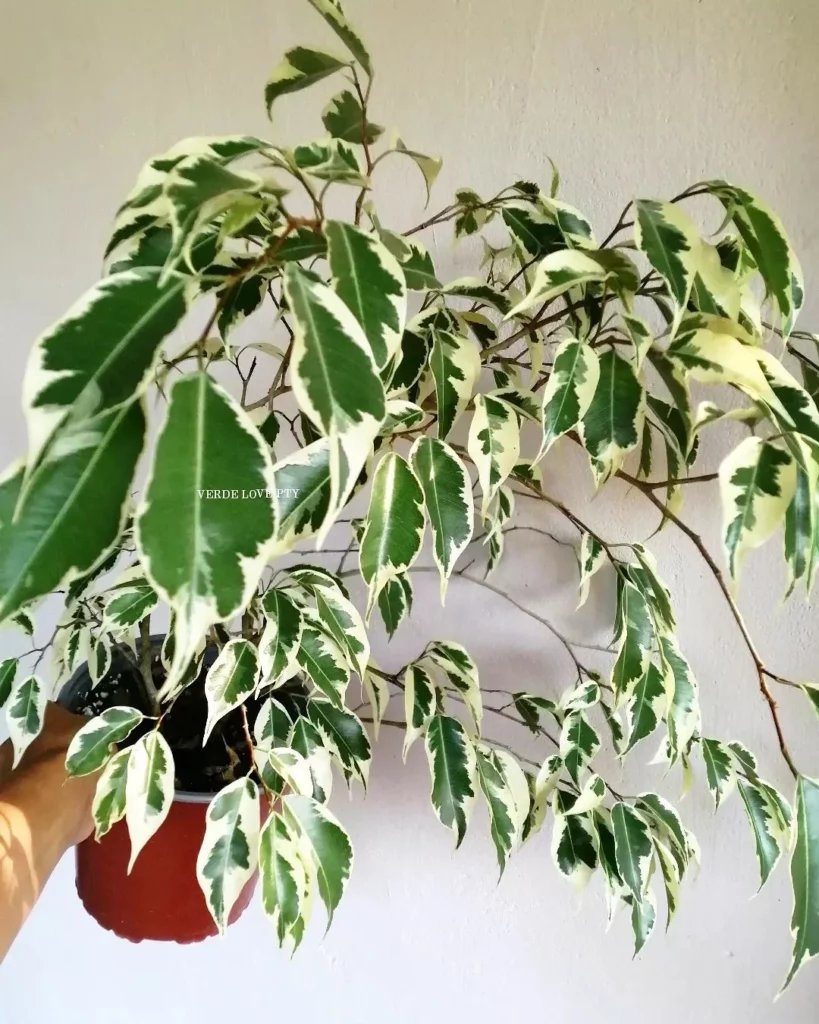
When caring for the Ficus benjamina Variegata, it is essential to provide it with the right conditions to thrive. This plant thrives in a bright location with indirect light.
Placing it near a north or east-facing window is ideal, as it allows the plant to receive the necessary light without being exposed to direct sunlight, which can scorch its delicate leaves.
In addition to proper lighting, the Ficus benjamina Variegata thrives in high humidity environments. To maintain the ideal humidity level, consider using a humidifier or placing a tray filled with water near the plant. Misting the leaves regularly can also help increase humidity.
When it comes to watering, it’s important to strike a balance. Overwatering can lead to root rot, while underwatering can cause the leaves to wilt. Check the top 2-3 inches of soil, and if it feels dry, it’s time to water.
However, make sure not to let the plant sit in standing water, as this can also cause root rot. Using filtered or distilled water can help prevent the appearance of hard water marks on the leaves.
| Common Name | Scientific Name |
|---|---|
| Ficus benjamina Variegata | Ficus benjamina ‘Variegata’ |
| Common Pests | Mealy bugs, Spider mites, Thrips, Scale |
| Preferred Light | Bright, indirect light |
| Watering Frequency | When top 2-3 inches of soil is dry |
How To Grow Ficus benjamina Variegata

Growing a thriving Ficus benjamina Variegata requires careful attention to the planting process and providing optimal growing conditions. This exquisite plant, also known as Variegated Ficus benjamina, adds a touch of elegance to any indoor or outdoor space with its stunning variegated foliage.
- Choose a bright location: Ficus benjamina Variegata thrives in bright, indirect light. Place it near a window that receives ample sunlight, but avoid direct sunlight as it can scorch the leaves.
- Ensure proper drainage: Use well-draining soil to prevent waterlogging, which can lead to root rot. Adding perlite or sand to the soil mix can improve drainage.
- Watering needs: Allow the top 2-3 inches of soil to dry out before watering. Overwatering can lead to root rot, so it’s essential to strike a balance. Use filtered or distilled water to prevent hard water marks on the leaves.
- Maintain high humidity: Ficus benjamina Variegata thrives in humid environments. You can increase humidity levels by misting the leaves regularly or placing a tray of water near the plant.
Propagation Tips for Ficus benjamina Variegata
If you desire to expand your collection of Ficus benjamina Variegata plants, propagation can be an exciting and rewarding process. Stem cuttings and air layering are popular methods for propagating this stunning plant.
Stem cuttings: Select a healthy stem with at least two nodes and remove any lower leaves. Dip the cut end in rooting hormone and plant it in a well-drained potting mix. Keep the soil moist and provide indirect light. After a few weeks, roots will develop, signaling successful propagation.
Air layering: Choose a healthy branch and create a small incision, exposing the inner part of the stem. Surround the incised area with moist sphagnum moss, securing it with plastic wrap.
Propagation Tips for Ficus benjamina Variegata

Propagating Ficus benjamina Variegata can be an exciting and rewarding experience, allowing you to expand your collection or share this beautiful plant with friends and family. There are several effective techniques you can use to propagate this variegated cultivar, including stem cuttings and air layering.
Stem Cuttings: To propagate Ficus benjamina Variegata using stem cuttings, follow these simple steps:
- Choose a healthy stem with at least three sets of leaves.
- Cut the stem just below a leaf node, using a clean and sharp knife or shears.
- Remove the lower leaves, leaving only the topmost set of leaves.
- Dip the cut end of the stem in a rooting hormone powder to encourage root growth.
- Plant the stem cutting in a well-draining potting mix, ensuring that at least one node is below the soil surface.
- Keep the soil consistently moist and place the cutting in a warm and bright location, but avoid direct sunlight.
- After a few weeks, roots should start to develop, and you can gradually acclimate the new plant to its final growing conditions.
Air Layering: Air layering is another effective method for propagating Ficus benjamina Variegata. Here’s how to do it:
- Identify a healthy and mature branch that you want to propagate.
- Make a small wound on the branch by removing a small portion of the bark.
- Apply a rooting hormone to the wound to stimulate root growth.
- Wrap the wounded area with moist sphagnum moss, ensuring it stays in place with plastic wrap or a plastic bag.
- Keep the moss consistently moist and wait for roots to develop, which usually takes several weeks to a few months.
- Once roots have formed, carefully cut below the rooted section and plant it in a separate container with well-draining soil.
| Propagation Technique | Advantages | Disadvantages |
|---|---|---|
| Stem Cuttings | Simple and cost-effective | Takes longer to establish roots |
| Air Layering | Higher success rate | More time-consuming |
Quick Care Overview for Ficus benjamina Variegata
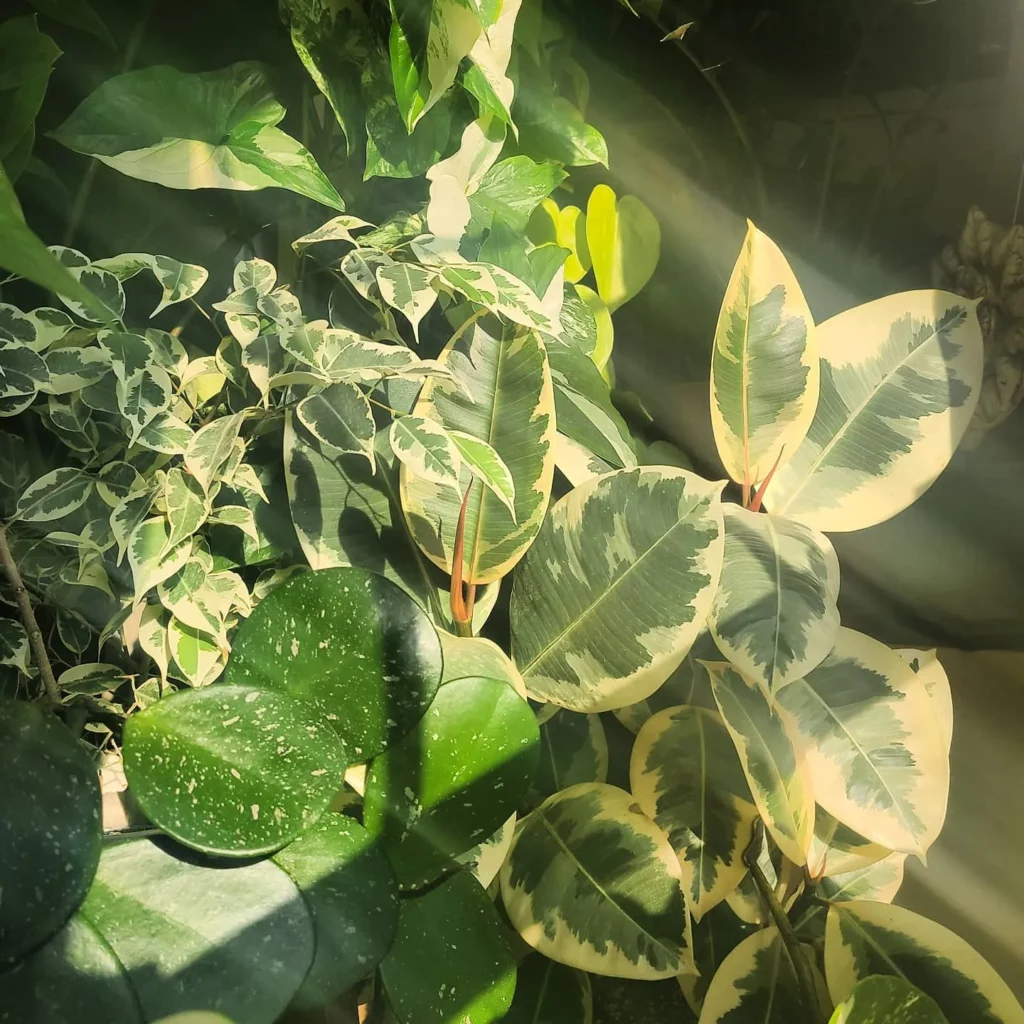
To ensure your Ficus benjamina Variegata thrives, here is a quick care overview encompassing the essential aspects of maintaining this stunning plant.
Light Requirements:
Ficus benjamina Variegata plants prefer bright, indirect light. Place your plant near a window with filtered light or provide artificial light if necessary. Avoid exposing it to prolonged direct sunlight, as this can cause leaf burn.
Watering:
Water your Ficus benjamina Variegata when the top 2-3 inches of soil are dry. It’s important to avoid overwatering, as this can lead to root rot. Use filtered or distilled water to prevent hard water marks on the leaves.
Humidity:
These plants thrive in high humidity. Increase humidity levels by placing a tray of water near the plant or using a humidifier. Regularly misting the leaves can also help maintain the required moisture levels.
Pruning:
Regular pruning is essential to maintain the shape and size of your Ficus benjamina Variegata. Remove any dead, damaged, or diseased leaves and branches. Pruning also encourages new growth and keeps the plant healthy.
| Pot Size | Frequency of Repotting |
|---|---|
| 4-6 inches | Every 1-2 years |
| 8-10 inches | Every 3-4 years |
| 12-14 inches | Every 5-6 years |
Potting and Repotting:
Choose a well-draining potting mix and a suitable-sized pot for your Ficus benjamina Variegata. Repot the plant annually, using fresh soil to provide adequate nutrients and space for root growth.
Light Requirements for Ficus benjamina Variegata
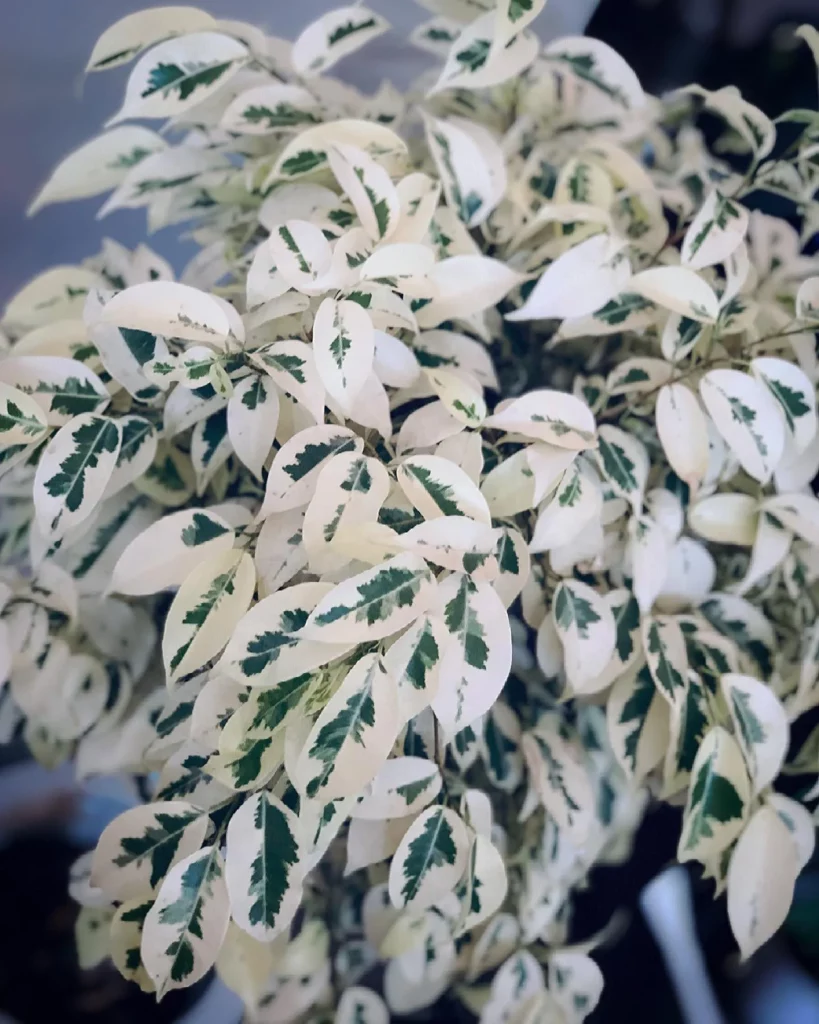
Providing appropriate lighting conditions is crucial for the overall well-being of your Ficus benjamina Variegata. This beautiful variegated plant thrives in bright but indirect light, simulating the dappled shade it would receive in its natural habitat.
Placing your Ficus benjamina Variegata near a north or east-facing window is ideal, as it allows the plant to receive the optimal amount of light without being exposed to direct sunlight, which can scorch its delicate leaves.
If you’re growing your Ficus benjamina Variegata indoors, ensure that it is placed in a room with ample natural light. If natural light is limited in your home, you can supplement it with artificial lighting using grow lights specifically designed for indoor plants.
This will help maintain the plant’s health and promote lush foliage growth.
| Light Requirement | Light Level |
|---|---|
| Bright Indirect Light | 4-6 hours of filtered sunlight per day |
| Artificial Grow Lights | 12-14 hours per day |
| Direct Sunlight | Avoid direct sunlight to prevent leaf burning |
Signs of Inadequate Light
- Yellowing or drooping leaves
- Long, leggy stems
- Reduced leaf variegation or loss of variegation
Soil Requirements for Ficus benjamina Variegata
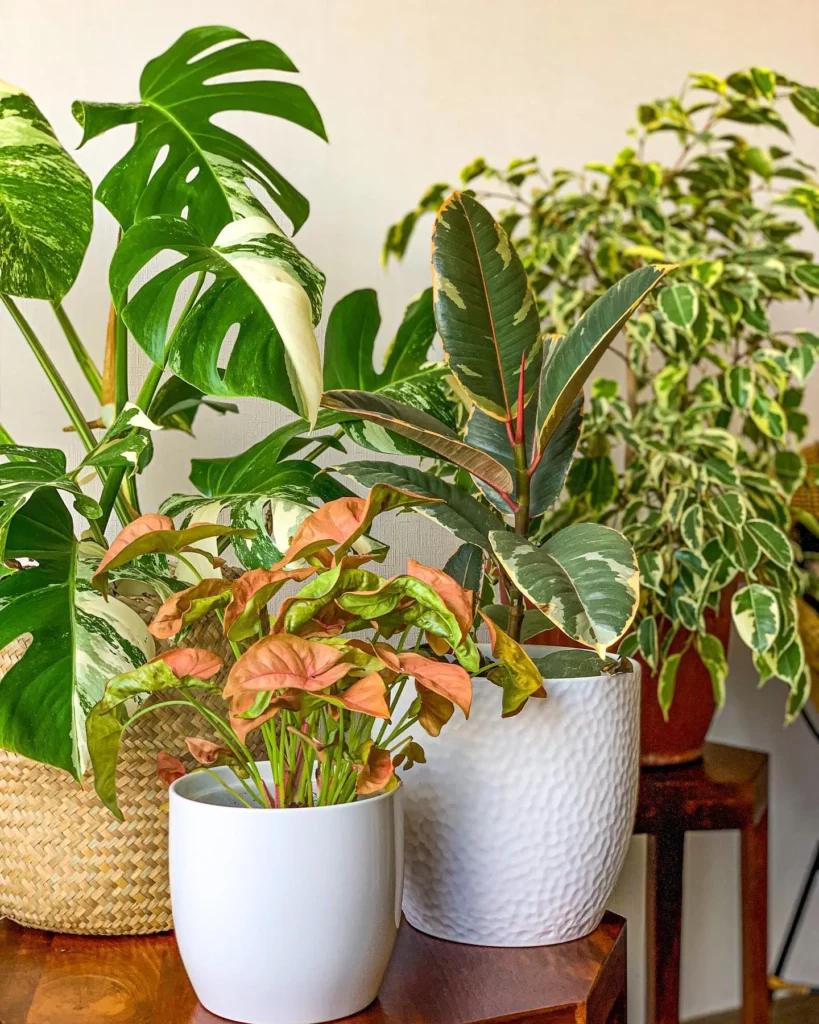
Creating the right soil environment is key to supporting the growth and development of your Ficus benjamina Variegata. This stunning plant thrives in well-draining soil that retains moisture without becoming waterlogged.
A balanced soil mixture consisting of peat moss, perlite or vermiculite, and a good-quality potting mix is ideal for creating the perfect soil composition.
Soil Preparation
Prior to planting or repotting your Ficus benjamina Variegata, it’s essential to ensure the soil is properly prepared. Start by filling the bottom of the pot or container with drainage material such as gravel or small stones to promote proper water flow.
Next, layer the soil mixture, making sure to evenly distribute it around the plant’s root system. Avoid packing the soil too tightly, as this can hinder water and nutrient absorption.
Regular Moisture Checks
Regularly monitoring the moisture levels of your Ficus benjamina Variegata’s soil is crucial. Stick your finger about 2 to 3 inches into the soil, and if it feels dry at that depth, it’s time to water your plant.
Potting and Repotting Ficus benjamina Variegata
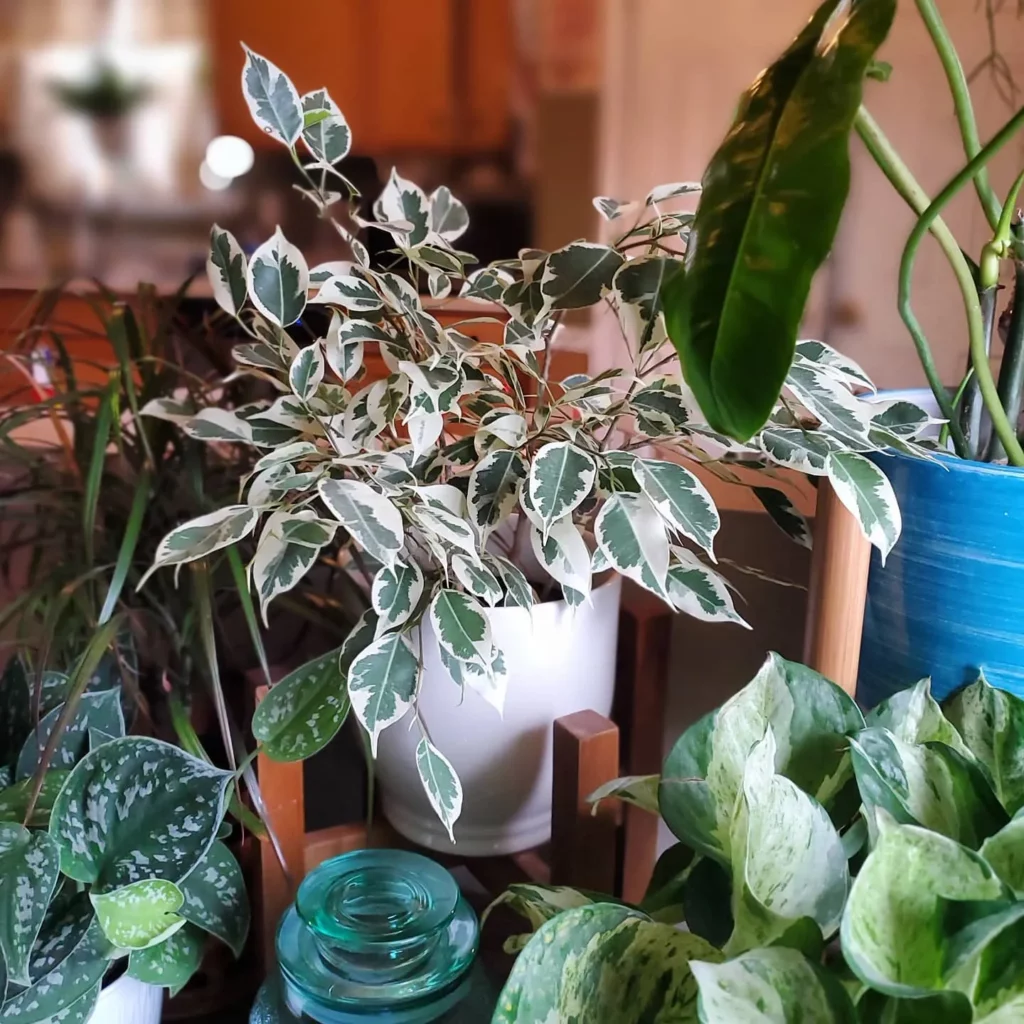
Proper potting and repotting techniques are vital for maintaining the health and vitality of your Ficus benjamina Variegata. This section will guide you through the process, ensuring your plant thrives in its new home.
When potting your Ficus benjamina Variegata, choose a container that allows for ample root growth. Opt for a pot with drainage holes to prevent waterlogging, which can lead to root rot.
Fill the bottom of the pot with a layer of well-draining soil and gently place the plant in the center. Fill the remaining space with a suitable potting mix, such as a combination of peat moss, perlite, and vermiculite, ensuring the roots are well-covered. Press the soil lightly to eliminate any air pockets.
If your Ficus benjamina Variegata has outgrown its current pot, repotting becomes necessary. This is typically done once every two to three years, preferably in spring.
Carefully remove the plant from its current container, gently loosening the roots if necessary. Place the plant in a new, slightly larger pot with fresh potting mix. Ensure the plant sits at the same depth as before, avoiding burying the stem too deeply.
Water thoroughly and monitor the plant closely during the initial weeks to ensure successful root establishment.
Tips for Potting and Repotting Ficus benjamina Variegata
- Choose a well-draining pot with drainage holes to prevent waterlogging.
- Use a suitable potting mix, such as a combination of peat moss, perlite, and vermiculite.
- Ensure the roots are well-covered with soil, pressing lightly to eliminate air pockets.
- Repot the plant every two to three years, preferably in spring.
- During repotting, gently loosen the roots and place the plant at the same depth as before.
- Water thoroughly after potting or repotting to encourage root establishment.
| Potting and Repotting Ficus benjamina Variegata | Summary |
|---|---|
| Choose a well-draining pot with drainage holes. | Ensures proper water drainage and prevents root rot. |
| Use a suitable potting mix. | A combination of peat moss, perlite, and vermiculite provides good drainage and nutrients. |
| Ensure roots are well-covered with soil. | Eliminates air pockets and promotes root growth. |
| Repot every two to three years. | Allows for root development and prevents the plant from becoming root-bound. |
| Gently loosen roots during repotting. | Facilitates root expansion and establishes the plant in its new container. |
| Water thoroughly after potting or repotting. | Encourages root establishment and aids in plant recovery. |
Pruning and Shaping Ficus benjamina Variegata
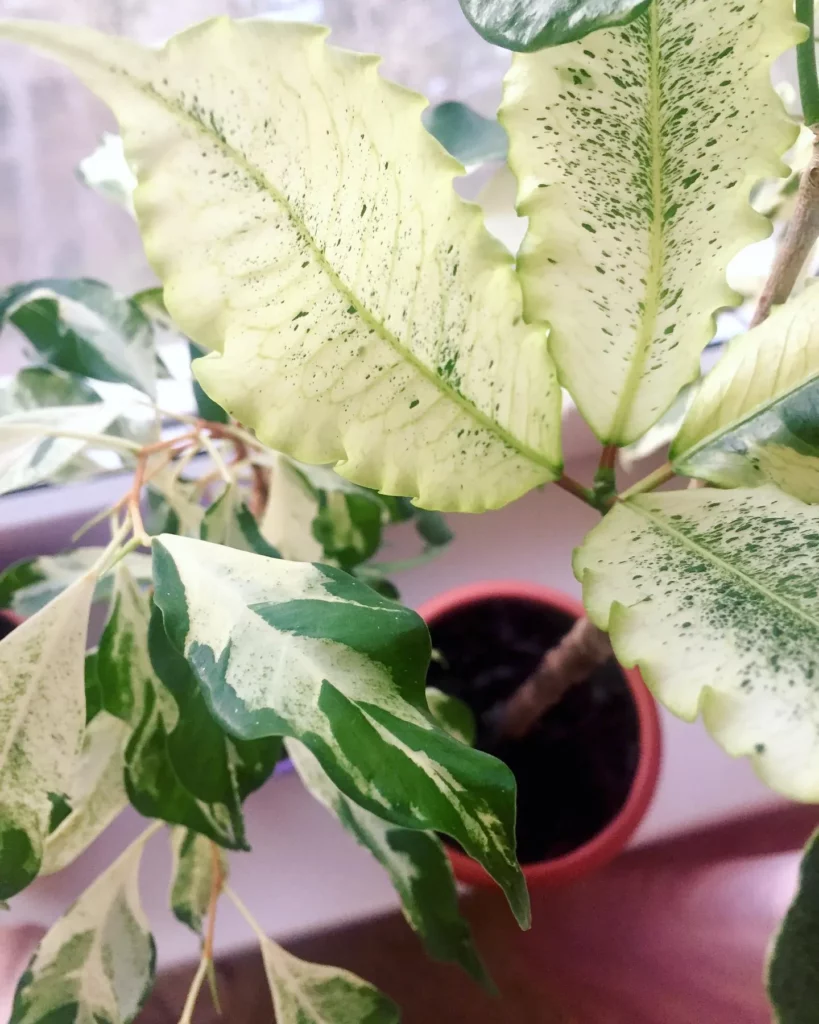
Pruning and shaping your Ficus benjamina Variegata not only enhances its aesthetic appeal but also promotes healthy growth and maintains its natural form.
Regular pruning helps to control the size and shape of the plant, preventing it from becoming leggy or overgrown. It also encourages the development of new growth and ensures that the plant remains robust and healthy.
When pruning your Ficus benjamina Variegata, it is important to use sharp, clean pruning shears to make clean cuts. Begin by removing any dead, diseased, or damaged branches. This will help to improve the overall appearance of the plant and prevent the spread of diseases.
Next, selectively prune any branches that are growing in undesirable directions or crowding the interior of the plant. Aim to create an open and airy structure that allows light to penetrate and air to circulate.
For best results, prune your Ficus benjamina Variegata in late winter or early spring, just before the start of the growing season. This will give the plant ample time to recover and produce new growth.
As you prune, step back periodically to assess the overall shape and balance of the plant. It may be helpful to use a mirror or take photographs from different angles to get a better perspective.
Pruning Tips for Ficus benjamina Variegata
- Remove dead, diseased, or damaged branches first.
- Avoid pruning more than one-third of the plant’s total foliage at once.
- Make clean cuts just above a leaf node or bud to encourage new growth.
- Thin out crowded or crossing branches to improve air circulation.
- Regularly check for any signs of pests or diseases while pruning and take appropriate action if necessary.
| Pruning Frequency | Pruning Tools | Best Time to Prune |
|---|---|---|
| Once per year | Sharp pruning shears | Late winter or early spring |
Temperature Requirements for Ficus benjamina Variegata
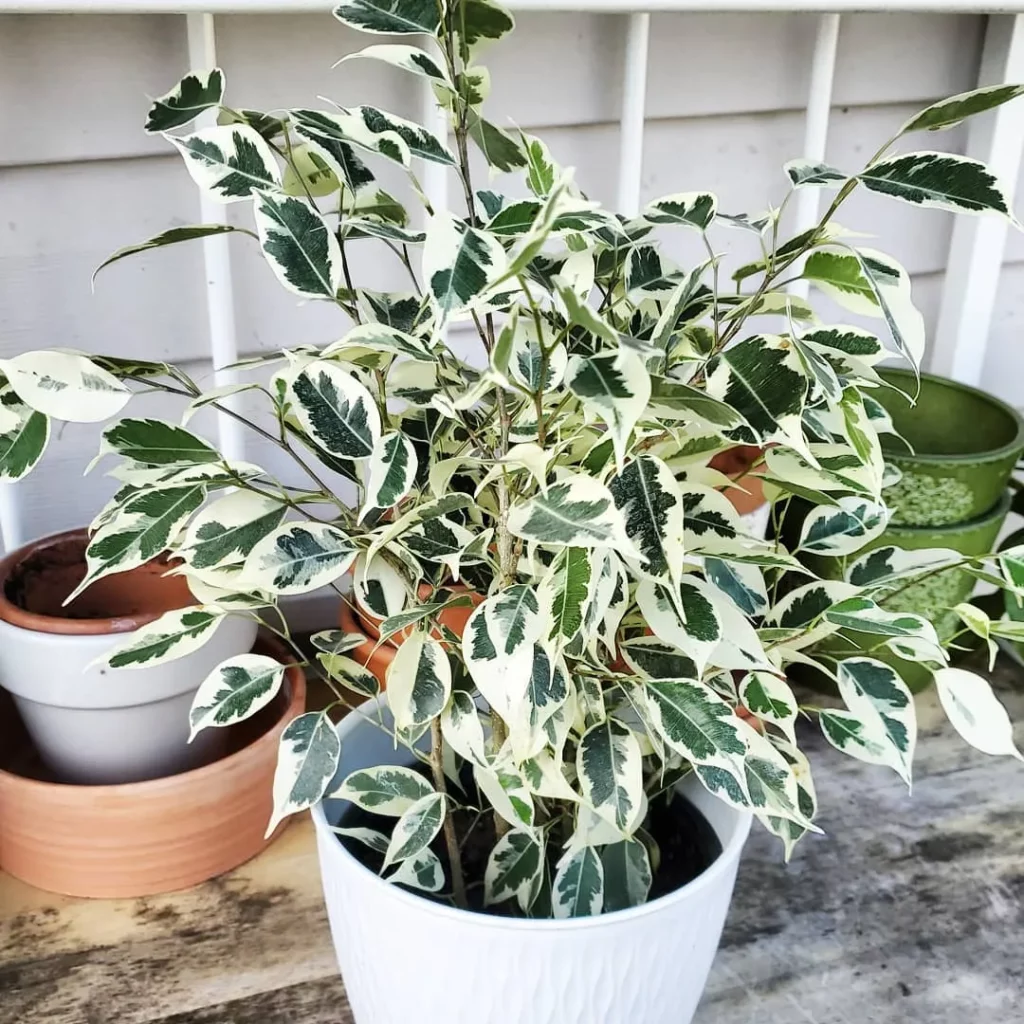
Understanding the temperature requirements of your Ficus benjamina Variegata is crucial for creating a thriving environment. This stunning variegated plant thrives in temperatures between 60°F and 75°F (15°C – 24°C), making it well-suited for indoor cultivation in most regions.
However, it is important to note that this plant is sensitive to temperature fluctuations, particularly drafts and cold air. Extreme temperatures can lead to leaf drop and overall decline in plant health.
During the summer months, it is best to keep your Ficus benjamina Variegata in a well-ventilated area away from direct sunlight. This will help prevent the temperature from rising too high, as excessive heat can cause stress to the plant.
If the temperature rises above 85°F (29°C), consider providing some shade or moving the plant to a cooler location temporarily.
In the winter, ensure that your Ficus benjamina Variegata is shielded from cold drafts and sudden temperature drops. Ideally, maintain a constant temperature between 60°F and 75°F (15°C – 24°C) to support healthy growth.
Temperature Guidelines for Ficus benjamina Variegata:
| Temperature Range | Optimal Range | Tolerable Range |
|---|---|---|
| Summer | 60°F – 75°F (15°C – 24°C) | Below 85°F (29°C) |
| Winter | 60°F – 75°F (15°C – 24°C) | Above 50°F (10°C) |
Humidity Requirements for Ficus benjamina Variegata
Maintaining adequate humidity levels is essential for promoting healthy growth and preventing common issues in your Ficus benjamina Variegata.
This variegated ficus plant thrives in environments with moderate to high humidity, mimicking its natural habitat in tropical regions. Here are some care instructions to ensure you provide the proper humidity for your Ficus benjamina Variegata:
- Place a humidity tray filled with water and pebbles near your plant. As the water evaporates, it increases the moisture in the surrounding air.
- Mist the leaves regularly with distilled or filtered water to create a humid microclimate around the plant. Be sure not to mist too heavily, as this can lead to fungal diseases.
- Grouping your Ficus benjamina Variegata with other humidity-loving plants can help create a more humid environment.
Additionally, you can use a room humidifier to maintain consistent humidity levels if your home tends to be dry. Monitoring the humidity with a hygrometer can also help ensure you provide the ideal conditions for your Ficus benjamina Variegata.
Preventing Overly Dry or Humid Conditions
While Ficus benjamina Variegata prefers higher humidity levels, it’s important to strike a balance and avoid excessively dry or humid conditions. Here are some tips to prevent these extremes:
- Avoid placing your plant near drafts, heating vents, or air conditioning units, as these can dry out the air.
- If the air becomes too dry, consider using a humidifier or placing the plant in a well-lit bathroom or near a water source.
- On the other hand, if the air becomes too humid, ensure proper air circulation by opening windows or using fans.
| Humidity Levels | Recommended Range |
|---|---|
| Low Humidity | 40-50% |
| Medium Humidity | 50-70% |
| High Humidity | Above 70% |
Watering Ficus benjamina Variegata
Correct watering practices are key to nurturing your Ficus benjamina Variegata, ensuring it receives the right amount of moisture for healthy growth.
The watering needs of your Ficus benjamina Variegata will depend on various factors such as the size of the plant, the environment it is in, and the time of year. Here are some important watering instructions to keep in mind:
- Check the soil: Before watering, always check the moisture level of the soil. Stick your finger about 2-3 inches into the soil to see if it feels dry. If the soil is still moist, wait a bit longer before watering.
- Be mindful of humidity: Ficus benjamina Variegata plants thrive in high humidity environments, so it’s a good idea to provide some extra moisture. You can do this by misting the leaves with water or placing a tray filled with water near the plant to increase humidity.
- Watering frequency: As a general guideline, water your Ficus benjamina Variegata once every 7-10 days during the growing season (spring and summer). In the cooler months, reduce watering to once every 2-3 weeks.
- Avoid overwatering: Overwatering can lead to root rot and other issues. Make sure the pot has excellent drainage and avoid letting the plant sit in standing water. Empty any excess water from the saucer or tray after watering.
| Watering Tips for Ficus benjamina Variegata |
|---|
| Check soil moisture regularly |
| Mist leaves or use a humidifier |
| Water once every 7-10 days in summer |
| Water once every 2-3 weeks in winter |
| Avoid overwatering and ensure good drainage |
Fertilizing Ficus benjamina Variegata
Providing adequate nutrients through proper fertilization is essential for promoting the vigorous growth and vibrant foliage of your Ficus benjamina Variegata.
This section will guide you on how to fertilize your plant effectively to ensure its optimal health and beauty.
When to Fertilize:
Ficus benjamina Variegata plants benefit from regular fertilization during the growing season, which typically spans from spring to summer. It is recommended to apply a balanced, water-soluble fertilizer once a month or every six weeks.
However, always refer to the specific fertilizer’s instructions for the precise frequency and dosage.
Choosing the Right Fertilizer:
Selecting the appropriate fertilizer is crucial for providing the necessary nutrients to your Ficus benjamina Variegata. Look for a balanced fertilizer with an equal ratio of nitrogen (N), phosphorus (P), and potassium (K).
For example, a 10-10-10 or 20-20-20 fertilizer is suitable for promoting overall plant health and foliage development. Additionally, consider using a slow-release fertilizer to provide a continuous supply of nutrients over an extended period.
Applying Fertilizer:
When applying fertilizer to your Ficus benjamina Variegata, it is essential to follow the package instructions carefully. Dilute the fertilizer as directed and evenly distribute it around the base of the plant.
Avoid applying fertilizer directly to the foliage or near the stem, as this can cause burns or other damage. After fertilizing, water the plant thoroughly to ensure proper absorption of the nutrients into the soil.
| Fertilizer | Nitrogen (N) | Phosphorus (P) | Potassium (K) | Application Frequency |
|---|---|---|---|---|
| 10-10-10 | 10% | 10% | 10% | Once a month |
| 20-20-20 | 20% | 20% | 20% | Every six weeks |
| Slow-release fertilizer | Varies | Varies | Varies | As per package instructions |
Pest Control for Ficus benjamina Variegata
Protecting your Ficus benjamina Variegata from pests is crucial to maintain its health and beauty. Common pests that may infest this plant include mealy bugs, spider mites, thrips, and scale.
Fortunately, there are effective strategies to prevent and control these pesky invaders.
1. Regular Inspections: To catch pest problems early, it’s important to inspect your Ficus benjamina Variegata regularly. Look for signs of infestation such as webbing, tiny insects, or yellowing leaves. If you spot any issues, take action immediately.
2. Natural Remedies: For minor pest infestations, you can try using natural remedies. Some options include spraying the plant with a gentle soap and water solution, introducing beneficial insects like ladybugs or predatory mites, or wiping the leaves with rubbing alcohol-soaked cotton balls to remove pests.
3. Chemical Treatments: If natural remedies fail to control the pest problem, you may need to resort to chemical treatments. Always follow the instructions provided on the pesticide label and wear protective clothing. Be sure to choose a pesticide specifically formulated for use on Ficus benjamina Variegata and consult with a professional if needed.
| Pest | Symptoms | Treatment |
|---|---|---|
| Mealy Bugs | White, cottony clusters on stems and undersides of leaves | Apply a neem oil or insecticidal soap spray, focusing on infested areas |
| Spider Mites | Webbing, yellow speckles, and wilting leaves | Introduce predatory mites or use a miticide, ensuring thorough coverage of the plant |
| Thrips | Silver or bronze streaks on leaves, distorted growth | Use insecticidal soap or neem oil spray, targeting both sides of the leaves |
| Scale | Small, raised bumps along stems and leaves | Apply rubbing alcohol with a cotton swab to dislodge or use an insecticidal oil spray |
Common Problems with Ficus benjamina Variegata
While Ficus benjamina Variegata is generally a resilient plant, it can face specific challenges that require attention and prompt action. Here are some common problems you may encounter when caring for your Ficus benjamina Variegata and how to address them:
Pest Infestation:
Ficus benjamina Variegata can be susceptible to pests such as mealy bugs, spider mites, thrips, and scale. If you notice signs of infestation, such as webbing, brown spots, or sticky residue on the leaves, it’s important to take immediate action.
To combat pests, you can use organic insecticidal soap or neem oil spray. Make sure to thoroughly coat both sides of the leaves and repeat the treatment every 7-10 days until the infestation is under control.
Additionally, regularly inspecting your plant and maintaining a clean environment can help prevent future pest problems.
Leaf Drop:
Leaf drop is a common issue with Ficus benjamina Variegata and can be caused by various factors, including sudden changes in temperature or lighting conditions, over or under watering, root damage, or stress. To address this problem, it’s crucial to identify the underlying cause.
Ensure your plant is placed in a stable environment with consistent temperatures and avoid exposing it to drafts or direct sunlight. Proper watering is also essential.
Check the moisture level of the soil regularly and adjust your watering schedule accordingly, allowing the top 2-3 inches of soil to dry before watering again. If necessary, repotting the plant using fresh, well-draining soil can help rejuvenate it.
Yellowing Leaves:
Yellowing leaves on Ficus benjamina Variegata can be a sign of both overwatering and underwatering. It’s crucial to strike the right balance to maintain the plant’s health.
Ensure that you are not watering the plant too frequently or letting it sit in standing water, which can lead to root rot. On the other hand, if the yellowing leaves are accompanied by dry, crispy edges, it may indicate underwatering.
Adjust your watering routine accordingly and monitor the moisture level of the soil to help prevent yellowing leaves.
| Problem | Cause | Solution |
|---|---|---|
| Pest Infestation | Mealy bugs, spider mites, thrips, scale | Use organic insecticidal soap or neem oil spray, maintain a clean environment, and repeat treatment every 7-10 days as needed |
| Leaf Drop | Sudden temperature or lighting changes, over or under watering, root damage, stress | Provide a stable environment with consistent temperatures, avoid drafts and direct sunlight, adjust watering schedule, and consider repotting with fresh, well-draining soil if necessary |
| Yellowing Leaves | Overwatering or underwatering | Strike a balance in watering frequency, avoid standing water, and monitor soil moisture to prevent yellowing leaves |
Conclusion
Armed with the insights from this comprehensive Ficus benjamina Variegata Care Guide, you now have the tools and knowledge to nurture and enjoy the beauty of this remarkable plant.
The Ficus benjamina Variegata, also known as the Variegated Ficus benjamina, is a visually stunning plant that can thrive both indoors and outdoors in warmer zones 10-11. It prefers a bright location with indirect light and high humidity, making it an excellent choice for bathrooms, kitchens, or any room with ample natural light.
When it comes to watering, it’s important to check the moisture level of the soil. Water the plant when the top 2-3 inches of soil is dry, and avoid overwatering, as it can lead to root rot. Using filtered or distilled water can prevent hard water marks on the foliage, ensuring that your Ficus benjamina Variegata retains its vibrant appearance.
Pests can sometimes be a challenge for the Ficus benjamina Variegata. Common pests include mealy bugs, spider mites, thrips, and scale. Regular inspection and treatment with appropriate organic or chemical insecticides can help keep these pests at bay.
To ensure the longevity and aesthetics of your Ficus benjamina Variegata, regular pruning and shaping are necessary. Remove dead or yellowing leaves and branches to encourage new growth and maintain a desired size and shape. Remember to exercise caution when handling the plant, as the sap can cause skin and eye irritation and is toxic if ingested.
Make sure to check out our article on Ficus benjamina Starlight Care Guide. And after reading that Ficus article, check out our article on Ficus binnendijkii Alii Care Guide.
FAQ
Q: Where should I place my Ficus benjamina Variegata plant?
A: The Ficus benjamina Variegata plant prefers a bright location with indirect light.
Q: How often should I water my Ficus benjamina Variegata plant?
A: Water your Ficus benjamina Variegata plant when the top 2-3 inches of soil is dry.
Q: Can I use tap water to water my Ficus benjamina Variegata plant?
A: It is recommended to use filtered or distilled water to prevent hard water marks on the leaves.
Q: What pests should I watch out for with my Ficus benjamina Variegata plant?
A: Common pests that may affect Ficus benjamina Variegata plants include mealy bugs, spider mites, thrips, and scale.
Q: Can I grow Ficus benjamina Variegata indoors?
A: Yes, Ficus benjamina Variegata can be grown indoors or outdoors in warmer zones 10-11.
Q: How long do Ficus benjamina Variegata plants typically live?
A: Weeping figs, including Ficus benjamina Variegata, are known for their longevity and can live between 20 to 50 years.
Q: How do I propagate Ficus benjamina Variegata plants?
A: Ficus benjamina Variegata plants can be propagated from stem cuttings.
Q: How often should I repot my Ficus benjamina Variegata plant?
A: Ficus benjamina Variegata plants should be repotted annually in many cases.


